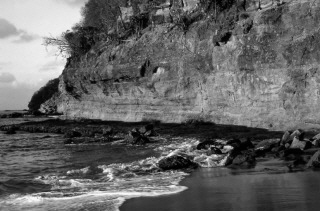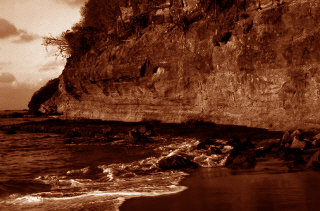GrayScaleToMultitoneCommand Class
- This class was designed for use with grayscale images. If the image being used is not grayscale, this class only affects those pixels or areas of the image where Red = Green = Blue.
- Monotone conversion is possible by setting Type to Replace, which clears the palette.
- This class gives you the option of having the toolkit generate the array of colors to use or creating the array of colors to use yourself.
-
To have the toolkit generate the array of colors:
- If the image is binary, call GrayScaleToMultitoneCommand with Tone set to GrayScaleToMultitoneCommandToneType.MonoTone, Distribution set to GrayScaleToMultitoneCommandDistributionType.Linear and the color you wish to use set in Color. The GrayscaleMode property will be set by GrayScaleToDuotoneCommand class object to determine the kind of grayscale palette being used. If the GrayscaleMode property is GrayscaleMode.OrderedInverse or GrayscaleMode.NotOrdered, then the color set in the Color property for the GrayScaleToMultitoneCommand class object will become the first color in the array generated by the toolkit, and the toolkit will create the second color in the array. The Color array will be updated with these two colors. If the GrayscaleMode property is a value other than GrayscaleMode.OrderedInverse or GrayscaleMode.NotOrdered, then the color set in the Color property for the GrayScaleToMultitoneCommand class object will become the second color in the array generated by the toolkit, and the toolkit will create the first color in the array. The Color property will be updated with these two colors.
-
If the image is grayscale (not binary) call the GrayScaleToMultitoneCommand with Distribution set to GrayScaleToMultitoneCommandDistributionType.Linear. The GrayScaleToMultitoneCommand will take the color(s) set in the Color property and generate a 256 color gradient for each color.
- If the Tone is set to GrayScaleToMultitoneCommandToneType.Duotone, set two colors in the Color property. The toolkit will create a 256 color array for each color.
- If the Tone is set to GrayScaleToMultitoneCommandToneType.Tritone, set three colors in the Color property. The toolkit will create a 256 color array for each color.
- If the Tone is set to GrayScaleToMultitoneCommandToneType.Quadtone, set four colors in the Color property. The toolkit will create a 256 color array for each color.
-
If the image is not grayscale (it is color) call the GrayScaleToMultitoneCommand with Distribution set to GrayScaleToMultitoneCommandDistributionType.Linear. The GrayScaleToMultitoneCommand will take the color(s) set in the Color property and generate a 256 color gradient for each color. These colors will be used to change only those pixels in the color image for which Red = Green = Blue.
-
To use a user-defined array of colors:
- If the image is binary, call GrayScaleToMultitoneCommand with Tone set to GrayScaleToMultitoneCommandToneType.Monotone, Distribution set to GrayScaleToMultitoneCommandDistributionType.UserDefined and the two colors you wish to use in the Gradient property.
-
If the image is grayscale (not binary) call GrayScaleToMultitoneCommand with Distribution set to GrayScaleToMultitoneCommandDistributionType.UserDefined.
- If the Tone is set to GrayScaleToMultitoneCommandToneType.Duotone, set 512 colors (256 for each basic color) in the Gradient property.
- If the Tone is set to GrayScaleToMultitoneCommandToneType.Tritone, set 768 colors (256 for each basic color) in the Gradient property.
- If the Tone is set to GrayScaleToMultitoneCommandToneType.Quadtone, set 1024 colors (256 for each basic color) in the Gradient property.
-
If the image is not grayscale (it is color) call GrayScaleToMultitoneCommand with Distribution set to GrayScaleToMultitoneCommandDistributionType.UserDefined. (See the expanded explanation in i, ii and iii of (b) above.) These colors will be used to change only those pixels in the color image for which Red = Green = Blue.
- This class supports 12 and 16-bit grayscale and 48 and 64-bit color images. Support for 12 and 16-bit grayscale and 48 and 64-bit color images is available only in the Document/Medical toolkits.
- This class does not support signed data images.
- This command does not support 32-bit grayscale images.
For more information, refer to Introduction to Image Processing With LEADTOOLS. For more information, refer to Grayscale Images.
Gray Scale to Multitone Function - Before

Gray Scale to Multitone Function - After

View additional platform support for this Gray Scale to Multitone function.
Run the GrayScaleToMultitoneCommand on an image.
using Leadtools;using Leadtools.Codecs;using Leadtools.ImageProcessing.Color;public void GrayScaleToMultitoneCommandExample(){// Load an imageRasterCodecs codecs = new RasterCodecs();codecs.ThrowExceptionsOnInvalidImages = true;RasterImage image = codecs.Load(Path.Combine(LEAD_VARS.ImagesDir, @"ImageProcessingDemo\Beauty16.jpg"));// Prepare the commandGrayScaleToMultitoneCommand command = new GrayScaleToMultitoneCommand();command.Colors = new RasterColor[2];command.Colors[0].R = 255;command.Colors[0].G = 255;command.Colors[0].B = 0;command.Colors[1].R = 255;command.Colors[1].G = 0;command.Colors[1].B = 0;command.Gradient = null;command.Distribution = GrayScaleToMultitoneCommandDistributionType.Linear;command.Tone = GrayScaleToMultitoneCommandToneType.Duotone;command.Type = GrayScaleToDuotoneCommandMixingType.ReplaceOldWithNew;command.Run(image);codecs.Save(image, Path.Combine(LEAD_VARS.ImagesDir, "Result.jpg"), RasterImageFormat.Jpeg, 24);}static class LEAD_VARS{public const string ImagesDir = @"C:\LEADTOOLS22\Resources\Images";}
